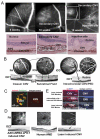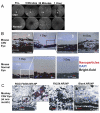Targeted intraceptor nanoparticle therapy reduces angiogenesis and fibrosis in primate and murine macular degeneration
- PMID: 23464925
- PMCID: PMC3634882
- DOI: 10.1021/nn305958y
Targeted intraceptor nanoparticle therapy reduces angiogenesis and fibrosis in primate and murine macular degeneration
Abstract
Monthly intraocular injections are widely used to deliver protein-based drugs that cannot cross the blood-retina barrier for the treatment of leading blinding diseases such as age-related macular degeneration (AMD). This invasive treatment carries significant risks, including bleeding, pain, infection, and retinal detachment. Further, current therapies are associated with a rate of retinal fibrosis and geographic atrophy significantly higher than that which occurs in the described natural history of AMD. A novel therapeutic strategy which improves outcomes in a less invasive manner, reduces risk, and provides long-term inhibition of angiogenesis and fibrosis is a felt medical need. Here we show that a single intravenous injection of targeted, biodegradable nanoparticles delivering a recombinant Flt23k intraceptor plasmid homes to neovascular lesions in the retina and regresses CNV in primate and murine AMD models. Moreover, this treatment suppressed subretinal fibrosis, which is currently not addressed by clinical therapies. Murine vision, as tested by OptoMotry, significantly improved with nearly 40% restoration of visual loss induced by CNV. We found no evidence of ocular or systemic toxicity from nanoparticle treatment. These findings offer a nanoparticle-based platform for targeted, vitreous-sparing, extended-release, nonviral gene therapy.
Figures




References
-
- Ambati J, Ambati BK, Yoo SH, Ianchulev S, Adamis AP. Age-Related Macular Degeneration: Etiology, Pathogenesis, and Therapeutic Strategies. Surv Ophthalmol. 2003:257–293. - PubMed
-
- Bunce C, Xing W, Wormald R. Causes of Blind and Partial Sight Certifications in England and Wales: April 2007–March 2008. Eye (Lond) 2010:1692–1699. - PubMed
-
- Jager RD, Mieler WF, Miller JW. Age-Related Macular Degeneration. N Engl J Med. 2008:2606–2617. - PubMed
-
- Pascolini D, Mariotti SP, Pokharel GP, Pararajasegaram R, Etya'ale D, Negrel AD, Resnikoff S. 2002 Global Update of Available Data on Visual Impairment: A Compilation of Population-Based Prevalence Studies. Ophthalmic Epidemiol. 2004:67–115. - PubMed
-
- Alon T, Hemo I, Itin A, Pe'er J, Stone J, Keshet E. Vascular Endothelial Growth Factor Acts as a Survival Factor for Newly Formed Retinal Vessels and Has Implications for Retinopathy of Prematurity. Nat Med. 1995:1024–1028. - PubMed
Publication types
MeSH terms
Substances
Grants and funding
LinkOut - more resources
Full Text Sources
Other Literature Sources
Medical

